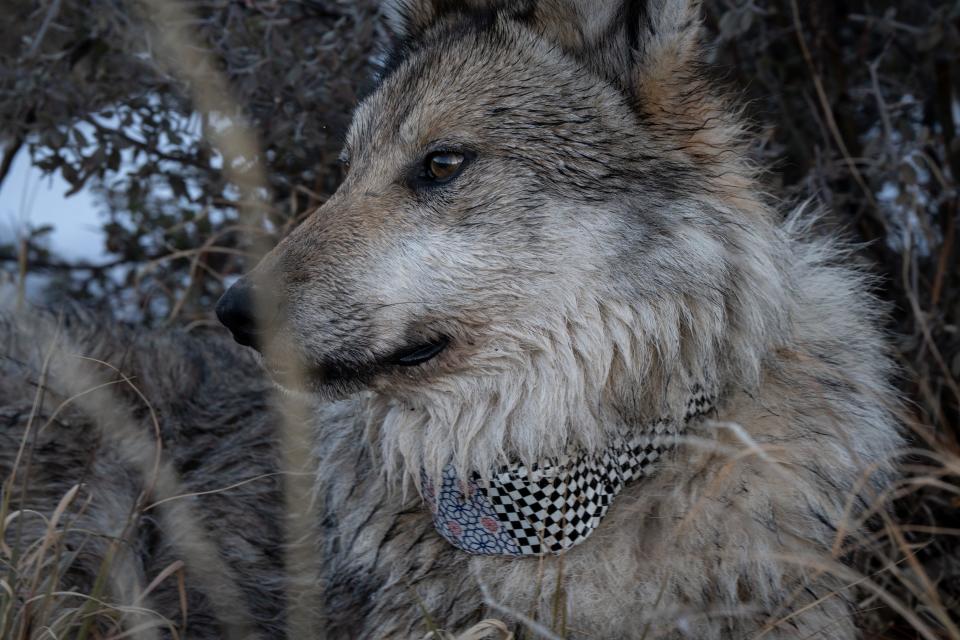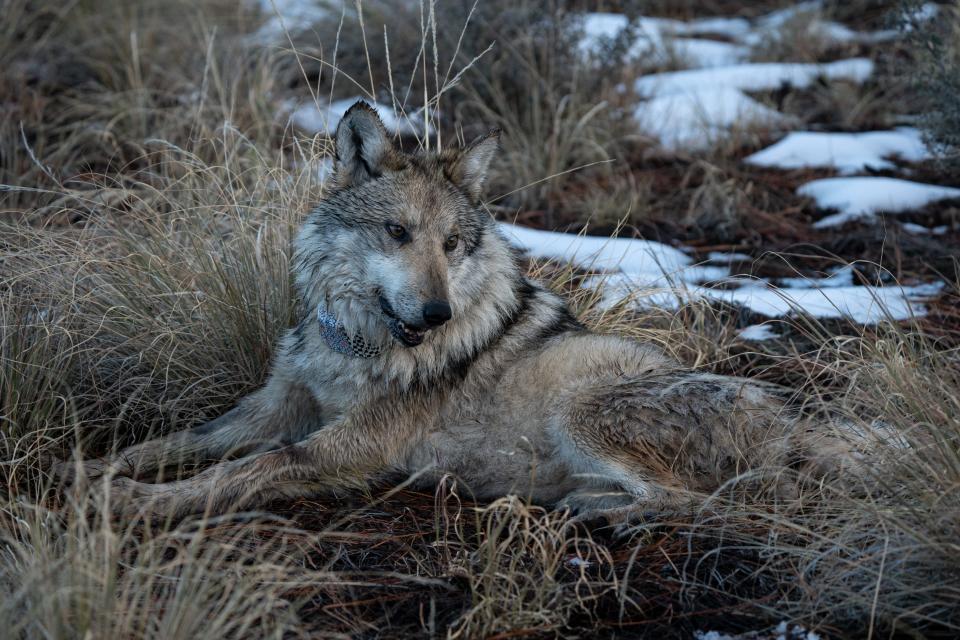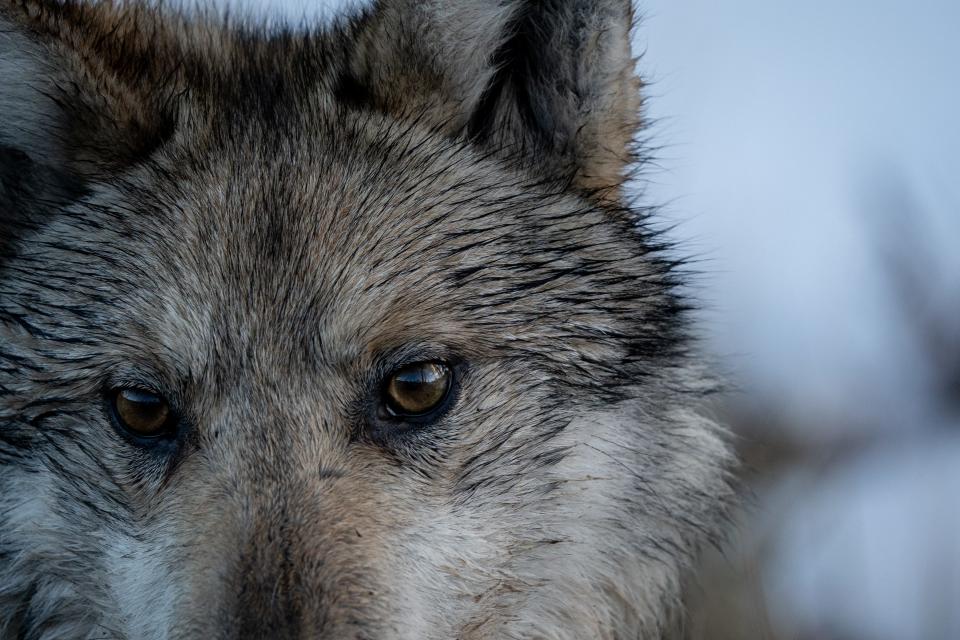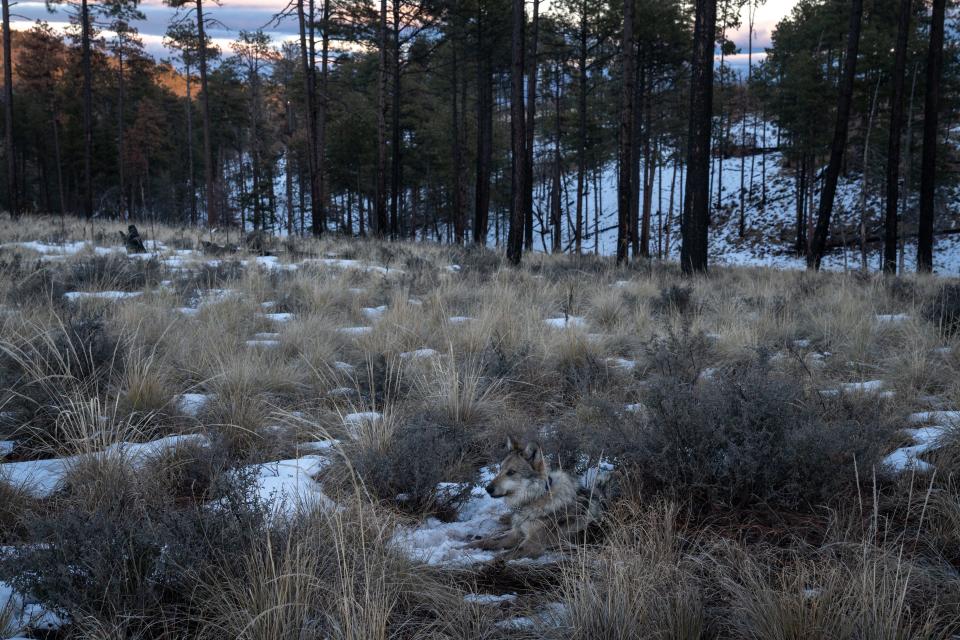How many Mexican gray wolves are in Arizona? Everything to know
State and federal wildlife agencies counted at least 257 Mexican gray wolves in the wild, according to figures released Tuesday in the annual census of the endangered species.
The survey marks the eighth consecutive year of growth, with 56 packs in the Mexican wolf habitat area, which includes parts of Arizona and New Mexico south of Interstate 40. There are at least 113 wolves in Arizona and 144 in New Mexico.
Mexican gray wolves were nearly eliminated from the wild in the 1970s and have struggled on a precarious road to recovery after reintroduction efforts began in 1998.
“The 2023 data points out that the Mexican wolf recovery has come a long way since the first release,” said Jim deVos, Arizona Game and Fish Department’s Mexican wolf coordinator. “Each year, the free-roaming Mexican wolf population numbers increase and the areas they occupy expands.”

Monitoring and counting the wolf population annually is a multiagency effort between the U.S. Fish and Wildlife Service, Arizona and New Mexico’s game and fish departments and the U.S. Forest Service.
Officials released this year’s results after completing months of aerial and ground survey operations in February.
The population increased from 242 wolves in 2022 but still falls short of the population criteria of 320 wolves set in the revised 2022 wolf recovery plan. That number is the threshold to move toward taking the subspecies off the endangered species list.
“One of the primary goals of the program is to try to recover the Mexican wolf to the point it no longer needs the protections under the act, and that is getting them to a certain number for a certain period of time,” said Brady McGee, U.S. Fish and Wildlife Service’s Mexican wolf recovery coordinator.
Conservation groups still worry that low genetic diversity among the wild population will hinder recovery.
"The increase in Mexican wolf numbers in the wild is the result of hard work and coordination between many partners," said Craig Miller, senior Southwest representative for Defenders of Wildlife. "But without more effort to improve the genetics of the population, we can't celebrate yet. We have a long way to go for the Mexican gray wolf to fulfill its ecological potential."
Officials will continue monitoring the population, bolstering the gene pool by placing genetically valuable captive-born pups in wild dens and mitigating wolf-human conflict to one day delist the subspecies.
How do state and federal wildlife agencies count wolves?
The wildlife agencies count Mexican wolves throughout the year using telemetry collars during ground and aerial surveys to locate packs in the wild.
In the spring and fall, crews set traps to capture specific wolves, typically uncollared wolves or animals not yet documented. They avoid trapping in the summer and winter months as high or low temperatures can endanger captured wolves.
Telemetry collars are integral to tracking the population and wolves’ activities, and officials aim to have two collared wolves in each pack, typically on the alpha male and female. They use GPS and VHF radio signals to pinpoint wolves, and each wolf has a distinct combination of colored and patterned tape so officials can distinguish specific wolves from a distance.
“We feel we have a fairly accurate representation of the population out there,” said McGee, thanks to the 113 collared wolves in the wild, totaling 44% of the known population.

Trail cameras across the reintroduction area also help with annual counts, picking up specific collared wolves and depicting new ones.
By January, the agencies have a good idea of the wolf population but use aerial surveys to check their work. They conduct helicopter operations for two weeks, starting in the eastern part of the reintroduction area in New Mexico and continuing through the Arizona population.
They use the collars’ GPS and VHF signals to find packs in the wild, using cracker shells to startle and move wolves before using tranquilizer darts to capture targeted wolves. They count pack members as they run before landing to collect the darted wolf.
Veterinary staff conduct thorough health checks on captured wolves, vaccinating them against common diseases and drawing blood for genetic testing. They attach or replace collars as needed, as a collar has enough battery life to last five years.

The population is stable during the winter which is the ideal time to verify officials’ work throughout the year. Federal and state agencies meet to compare results, before releasing the final, official number.
Saving a species: Are Mexican gray wolves closer to recovery 25 years after they were returned to the wild?
Could Mexican gray wolves be removed from the endangered species list?
Following the upward trend in the wolf population in recent years, officials revised the wolf recovery plan in 2022 and set requirements for down-listing or delisting the subspecies from the endangered species list.
There are two criteria to begin the delisting process, which would take years to complete.
First, the wild population has to reach 320 wolves across the recovery area in Arizona and New Mexico. There must then be a 320 average for eight years, and the population in the last three years must be stable or increasing.

The agencies also have to foster genetically diverse captive pups that survive for at least two years, or successfully release genetically valuable adult wolves.
In 2023, wildlife biologists released 15 pups to wild dens that they hope will live to adulthood. They plan to continue releasing captive pups into wild dens this spring.
Of the 99 foster pups released in the wild since 2016, the 2023 survey found at least 15 have survived. Ten have successfully produced litters in the wild, contributing their genetics to the population.
“While recovery is in the future, examining the last decade of data certainly provides optimism that recovery will be achieved,” deVos said.
Endangered species: Wolves can't read maps, but wildlife managers say habitat borders are still effective
What’s next for Mexican wolf recovery?
Despite recent successes, wildlife managers will continue addressing challenges in Mexican wolf recovery, like conducting human-wolf conflict mitigation and bolstering genetic diversity.
While wolves primarily hunt elk, sometimes they will resort to cattle if prey availability is low. Officials regularly monitor pack activity near ranches and private land to avoid unwanted interactions.
They provide prey caches to supplement their diets and haze wolves to scare them away from ranches.
Despite these efforts, USFWS will issue kill permits to remove wolves who attack cattle. Ranchers can also legally shoot wolves that are actively pursuing their livestock.
Another ongoing issue is wolves’ lack of genetic diversity.
Wildlife conservation groups have expressed concerns that Mexican wolves are not genetically diverse enough to survive in the wild indefinitely. The current wolf population stems from the last seven wolves found in the 1970s.
Biologists have found the genetic variability in the wild population is equal to having just two individual wolves. Inbreeding can lead to physical deformities, decreased litter sizes and limit wolves’ lifespans.
“This bodes extraordinarily poorly for the future of the Mexican wolf,” said Michael Robinson, a senior conservation advocate for the Center for Biological Diversity. “If you lose the genetic diversity, you can’t regain it.”
He believes it is “vitally important” for Mexican gray wolves to travel north and breed with Northern gray wolves recently released in Colorado to diversify the gene pool.
Wildlife managers believe the wild population is doing well despite low genetic diversity, as the population continues to grow and wolves appear to be in good health.
“They’re reproducing in the wild well on their own,” said Aislinn Maestas, a public affairs specialist for USFWS. “Their population doubled in the last five years.”
McGee said USFWS ran genetic models in 2017 as part of the Mexican wolf recovery plan and found that if they release 22 wolves from captivity that survive to breeding age, the population would have genetics diverse enough to survive.
“We’re not seeing any genetic deformities or defects or low litter sizes,” McGee said.
“Having fostered Mexican wolves survive, disperse, pair up, breed and start packs of their own tells us that fostering is working. These genetically diverse wolves… play a vital role in boosting the genetic diversity of the wild population,” McGee said.
Hayleigh Evans covers environmental issues for The Arizona Republic and azcentral.com. Send tips or questions to hayleigh.evans@arizonarepublic.com.
Environmental coverage on azcentral.com and in The Arizona Republic is supported by a grant from the Nina Mason Pulliam Charitable Trust.
Sign up for AZ Climate, our weekly environment newsletter, and follow The Republic environmental reporting team at environment.azcentral.com and @azcenvironment on Facebook and Instagram.
You can support environmental journalism in Arizona by subscribing to azcentral today.
This article originally appeared on Arizona Republic: Mexican gray wolf census finds 257 endangered animals in the wild

